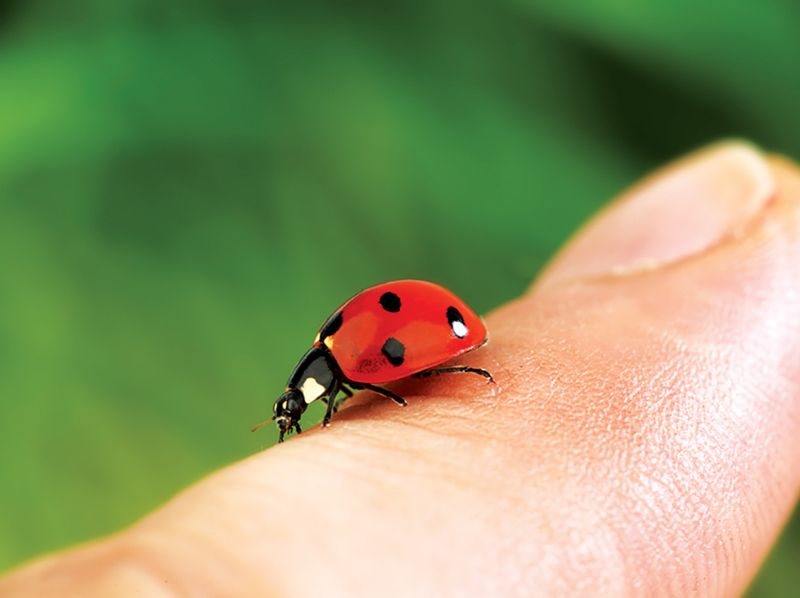- Home
- News, Articles & Reviews
We are hiring! Please click here to join our growing magazine delivery team in Gloucestershire!
Areas
Pets & Wildlife
Archive

Ladybirds: the aphid hunter
All Areas > Pets & Wildlife > Wildlife Matters
Author: John Bromley, Posted: Sunday, 24th April 2016, 08:00
Most people will be familiar with the commonly seen 7-spot ladybird, which is the epitome of the ladybird species with its bright red colour and seven black spots. It is this particular species from which their name is derived because early pictures of the Virgin Mary depict her in a red cloak, whilst the seven spots represent the seven Joys and seven Sorrows of Our Lady.
The bright colours are part of their defence mechanism
Ladybirds belong to the beetle family and are distinctive due to their round or oval shape and relatively small size, ranging from 1mm to 10mm. There are, however, 46 ladybird species found in the UK, but only 27 of these actually look like ladybirds – being brightly coloured in shades of red, orange, cream and yellow, and having anything from 2 to 22 spots.
The remaining species are rather dull by comparison and are not readily identified as ladybirds. The ladybirds’ bright colours are part of their defence mechanism to remind potential predators that they are very unpleasant tasting due to a yellow coloured strong smelling alkaline excretion they produce when threatened. That said, swifts and swallows are able to eat ladybirds, catching them on the wing.
Ladybirds only live for a year, the adults overwintering anywhere they can find shelter such as in leaf piles, bark crevices, long grass and so on. They become active in February and March and breed from late spring to early summer, laying eggs that hatch into a black grub-like larva, which do not look anything like a ladybird. However, the larvae are voracious hunters, feeding on aphids (greenfly, etc.), so are extremely beneficial to any garden.
7-spot ladybirds eat an average of 5000 aphids during its yearlong life cycle
The larvae grow quickly, shedding their skin four times before they pupate, and about a week later the new generation of adults will begin to emerge. The adult ladybirds also feed heavily on aphids to build up their reserves to enable them to successfully overwinter. On average a single 7-spot ladybird will eat around 5000 aphids during its year-long life cycle, making it a welcome sight in the garden.
The native ladybird species have few predators but are hunted by some spiders and wasp species, and they are also attacked by a parasitic fungus. However, in 2004 a new ladybird species was found in south east England. It is called the Harlequin Ladybird and originates from Asia, but was introduced by growers to various European countries to help manage aphids and inevitably it has now spread to the UK. This particular ladybird is very variable in colour and spot numbers and so is also called the Multicoloured Asian Ladybird. It is about 8mm in size, but its wide ranging colours make it difficult to distinguish from some of our native species.
Harlequin Ladybirds out-compete our native species
Sadly, the Harlequin Ladybird is both invasive and aggressive and will not only attack native ladybird species, but is able to outcompete them for food, and is a rapid breeder with adults laying eggs within five days of pupating. It is spreading rapidly and will ultimately cause a huge imbalance in the UK ladybird population. Further information regarding this threat to our native ladybird species is available at www.harlequin-survey.org.Other Images
Copyright © 2024 The Local Answer Limited.
Unauthorized use and/or duplication of this material without express and written permission from this site's author and/or owner is strictly prohibited. Excerpts and links may be used, provided that full and clear credit is given to The Local Answer Limited and thelocalanswer.co.uk with appropriate and specific direction to the original content.More articles you may be interested in...


© 2024 The Local Answer Limited - Registered in England and Wales - Company No. 06929408
Unit H, Churchill Industrial Estate, Churchill Road, Leckhampton, Cheltenham, GL53 7EG - VAT Registration No. 975613000You are leaving the TLA website...
You are now leaving the TLA website and are going to a website that is not operated by us. The Local Answer are not responsible for the content or availability of linked sites, and cannot accept liability if the linked site has been compromised and contains unsuitable images or other content. If you wish to proceed, please click the "Continue" button below:




